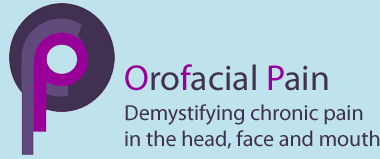
Clinician Information
Introduction
Pain is an unpleasant emotional and physical experience. There is healthy pain and unhealthy pain. The healthy pain is there to protect your body from harm is often regarded as an important part of the neuro-immune system. Unhealthy or chronic pain by definition is a disease of the neuromatrix (nerves and brain system) with no health benefits.
30% of the Western population live with chronic pain; it is a common problem. We all respond to pain in different ways depending upon our genetics, culture, beliefs, gender, pain experience, environment, dependants and many other factors.
A TED lecture explaining what pain is, is definitely worth watching:
You can also access this basic overview of how pain is classified and information about different pain states. Pain around the head face and mouth region is particularly challenging – see a summary of orofacial pain. The facial region contains structures vital for living: eyes for sight, mouth for breathing, communicating and eating, and ears for hearing.
In addition the essential organ, the brain, is also obviously in close proximity. It should be of no surprise, therefore, that any threat of damage to this region is likely to initiate primitive survival instincts and this may amplify the psychological and physiological consequences of pain in this region. This coupled to the level of sensory supply to the face probably helps explain the highly distressing nature of pain in this region. This partly explains as to why pain in the orofacial region causes such fear and emotion in patients.
The face and head include many structures (ears, joints, eyes, sinuses, teeth to name a few) so it’s often very complicated getting the diagnosis right.
With this website we hope to unravel some myths about pain in the face, mouth, head and neck, we hope you find this site useful in providing you up to date info about your condition.
Do feedback to us any comments you may have as we would be interested to hear your opinion.
Referral information for dentists
When to refer patients with orofacial pain:
- For referral to Kings College Hospital Orofacial pain Services – https://www.smartsurvey.co.uk/s/seldentalreferrals
New Guidance for Patients with Temporomandibular disorders 2024 - Management of painful Temporomandibular disorder in adults NHS England Getting It Right First Time (GIRFT) and Royal College of Surgeons’ Faculty of Dental Surgery by E Beecroft, J Palmer, C Penlington
https://www.rcseng.ac.uk/dental-faculties/fds/publications-guidelines/clinical-guidelines/
Other information
This section of the website includes:
- Summary of Orofacial Pain
- Useful pain lectures for clinicians
- Medication advice sheets
- Orofacial pain assessment
- Orofacial pain diagnosis
- Orofacial pain management
- Orofacial pain pathways
- Orofacial pain patient leaflets
- Useful web links
- Useful web documents
- CQC reporting requirements (for post traumatic pain patients)

